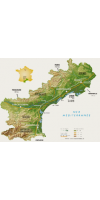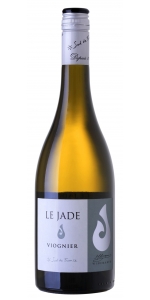Wine from Pays d'Oc

Pays d’Oc is located in the Southern France. This beautiful region is home to about 56 different kinds of grapes. Pays d’Oc is blessed with a Mediterranean climate. The region is mostly made with dry lands and occasional winds that come from the Mediterranean Sea. The winds sweep through the hills, steep slopes and vineyards of Pays d’Oc. Soils have diverse characteristics as a result of diverse weather that allow for different kinds of grapes to grow in Pays d’ Oc region.
Wines in Pays d’Oc come in red, white and rose. Red wines, such as Grenache, Mourvedre, Merlot, and Sauvignon, predominantly rule more than anything. White wines in the form of Chardonnay, Muscat, and Viognier make up about 15% of the total wine produced in this region. Over the years, Pays d’Oc has become a prominent region for wide varieties of grapes and wines.
Le Jade Viognier is made from 100 percent Viognier
The wine comes from sun-drenched vineyards planted on the best terroir - specially selected for its physical and geographical characteristics - on clay and limestone hillsides called "costières" (coastal region). The vineyards are only a few miles away from the Etang de Thau, a coastal lagoon that is situated between the port of Sète and Marseillan.
The color is a wonderful brilliant yellow with pearl tints. Intense and seductive aromas of ripe fruits, especially apricot, and floral notes with a hint of rose petals. The texture is very harmonious, generous, round and long. The finish is long and balanced with a good freshness.
Perfect as an aperitif, or great with richer dishes like langoustines, smoked or marinated salmon. Great too with guinea fowl in creamy or curry sauce. Serve it also with a broccoli and Roquefort soup or for dessert with a mango and pineapple tarte Tatin. An extremely versatile wine!
Review:
"This 100% Viognier comes from some of the region’s best vineyards, whose clay and limestone soils lend mineral and chalky notes. Night-picked fruit receives extended skin contact prior to partial cold fermentation in tanks (with a small percentage fermented in oak) and subsequent aging on the lees in large vats. No malolactic is done, which helps the wine retain its freshness as it presents the ripe tropical fruit, citrus, and apricot that define its profile along with a round, harmonious texture and floral notes such as rose petal. Pour it by the glass as an apéritif, or pair it with seafood dishes or a good blue cheese like Roquefort."
- The Somm Journal (April/May 2022)
Le Jade Viognier is made from 100 percent Viognier
The wine comes from sun-drenched vineyards planted on the best terroir - specially selected for its physical and geographical characteristics - on clay and limestone hillsides called "costières" (coastal region). The vineyards are only a few miles away from the Etang de Thau, a coastal lagoon that is situated between the port of Sète and Marseillan.
The color is a wonderful brilliant yellow with pearl tints. Intense and seductive aromas of ripe fruits, especially apricot, and floral notes with a hint of rose petals. The texture is very harmonious, generous, round and long. The finish is long and balanced with a good freshness.
Perfect as an aperitif, or great with richer dishes like langoustines, smoked or marinated salmon. Great too with guinea fowl in creamy or curry sauce. Serve it also with a broccoli and Roquefort soup or for dessert with a mango and pineapple tarte Tatin. An extremely versatile wine!
- back
Selected Options
Regions
Categories
Pricing
Countries
Regions
Grape Types
Wineries
Organic/Free Shipping
Tasting notes: A brand new wine from this tremendous vineyard, The Sokol Blosser Kalita Vineyard 2021 Estate Pinot Noir bursts with classic Yamhill-Carlton dark-fruit notes, including black cherry, cranberry, and blackberry. Warm spices, espresso, and woodsy forest floor are backed up with grippy tannins to balance the fruit.
Cazaux Gigondas Tour Sarrasine is made from 75% Grenache, 15% Syrah, 10% Mourvèdre. 45 year old vines on average.
This strong, warm wine comes from a selection of grapes planted on exceptional soils. The vineyards in Gigondas are situated on the arid hills of the Dentelles de Montmirail. The Mistral blows regularly on these slopes which limits the amount of treatment needed to the vines. The vines grow on stony soils and produce wine that can be kept easily for 10 yrs.
Intense, persistent red and dark fruit aromas. Raspberry, pepper and spice flavors. Silky tannins.





